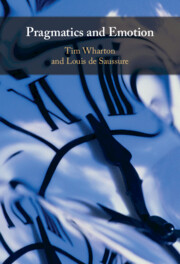Refine search
Actions for selected content:
73 results
Chapter 11 - A Lifespan Perspective of Emotion in Voice Perception
- from Section III - Emotion Perception and Elicitation
-
-
- Book:
- The Cambridge Handbook of Human Affective Neuroscience
- Published online:
- 16 September 2025
- Print publication:
- 02 October 2025, pp 219-247
-
- Chapter
- Export citation
Chapter 5 - Meaning expression through music in teacher–child interactions
-
-
- Book:
- The Arts and Meaning-Making with Children
- Published online:
- 11 September 2025
- Print publication:
- 25 September 2025, pp 92-112
-
- Chapter
- Export citation
Chapter 4 - Discourse as Communicative Expression
-
-
- Book:
- Heidegger's <i>Being and Time</i>
- Published online:
- 28 June 2025
- Print publication:
- 26 June 2025, pp 71-83
-
- Chapter
- Export citation
Chapter 5 - Art in a Complex, Dynamic Web of Functions
- from Part I - Art as a Complex Process
-
- Book:
- A Complex Systems View on the Visual Arts
- Published online:
- 20 March 2025
- Print publication:
- 03 April 2025, pp 93-112
-
- Chapter
- Export citation
13 - The Right to Freedom of Thought in Kenya
- from Part IV - Africa
-
-
- Book:
- The Cambridge Handbook of the Right to Freedom of Thought
- Published online:
- 06 March 2025
- Print publication:
- 13 March 2025, pp 167-178
-
- Chapter
- Export citation
Molecular characterisation and expression profiles of an odorant-binding proteins gene (FoccOBP9) from Frankliniella occidentalis
-
- Journal:
- Bulletin of Entomological Research / Volume 115 / Issue 1 / February 2025
- Published online by Cambridge University Press:
- 09 January 2025, pp. 74-83
-
- Article
- Export citation
Chapter 11 - Collingwood on “Painting Imaginatively” and the Expressive Nature of the Artwork
- from Part II - Issues in Collingwood’s Philosophy
-
-
- Book:
- Interpreting R. G. Collingwood
- Published online:
- 22 November 2024
- Print publication:
- 05 December 2024, pp 204-222
-
- Chapter
- Export citation
Chapter 10 - Collingwood on Imagination
- from Part II - Issues in Collingwood’s Philosophy
-
-
- Book:
- Interpreting R. G. Collingwood
- Published online:
- 22 November 2024
- Print publication:
- 05 December 2024, pp 184-203
-
- Chapter
- Export citation
Chapter 5 - Collingwood and Phenomenology
- from Part I - Situating Collingwood: Beyond Idealism
-
-
- Book:
- Interpreting R. G. Collingwood
- Published online:
- 22 November 2024
- Print publication:
- 05 December 2024, pp 82-101
-
- Chapter
- Export citation
3 - The Piano in Schubert’s Lied Texts
- from Part I - The Piano in Schubert’s World
-
-
- Book:
- Schubert's Piano
- Published online:
- 31 August 2024
- Print publication:
- 17 October 2024, pp 50-69
-
- Chapter
- Export citation
The Expressive Dimension of Free Exercise
-
- Journal:
- Journal of Law and Religion / Volume 39 / Issue 2 / May 2024
- Published online by Cambridge University Press:
- 29 April 2024, pp. 192-211
-
- Article
- Export citation
Chapter 8 - Romanticism
- from Part II - Inspiration and Expression
-
-
- Book:
- Vaughan Williams in Context
- Published online:
- 28 March 2024
- Print publication:
- 04 April 2024, pp 70-77
-
- Chapter
- Export citation
Cloning of three epsilon-class glutathione S-transferase genes from Micromelalopha troglodyta (Graeser) (Lepidoptera: Notodontidae) and their response to tannic acid
-
- Journal:
- Bulletin of Entomological Research / Volume 114 / Issue 2 / April 2024
- Published online by Cambridge University Press:
- 08 February 2024, pp. 172-179
-
- Article
- Export citation
8 - Pragmatics and Emotion
-
- Book:
- Pragmatics and Emotion
- Published online:
- 13 December 2023
- Print publication:
- 21 December 2023, pp 144-148
-
- Chapter
- Export citation
2 - Pragmatics and Emotion
-
- Book:
- Pragmatics and Emotion
- Published online:
- 13 December 2023
- Print publication:
- 21 December 2023, pp 13-28
-
- Chapter
- Export citation

Pragmatics and Emotion
-
- Published online:
- 13 December 2023
- Print publication:
- 21 December 2023
Free Speech in the Civil War
-
- Journal:
- Journal of Policy History / Volume 35 / Issue 4 / October 2023
- Published online by Cambridge University Press:
- 20 September 2023, pp. 475-504
-
- Article
- Export citation
1 - Protest, Dissent, and Democracy
-
- Book:
- Managed Dissent
- Published online:
- 04 May 2023
- Print publication:
- 11 May 2023, pp 17-34
-
- Chapter
- Export citation

Managed Dissent
- The Law of Public Protest
-
- Published online:
- 04 May 2023
- Print publication:
- 11 May 2023
No Harm, Still Foul: On the Effect-Independent Wrongness of Slurring
-
- Journal:
- Journal of the American Philosophical Association / Volume 9 / Issue 3 / September 2023
- Published online by Cambridge University Press:
- 22 March 2023, pp. 471-489
-
- Article
-
- You have access
- Open access
- HTML
- Export citation
